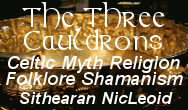Pagan Paths
Delve into a fascinating cultural force and deeply spiritual tradition that comprises the axe--power--of Brazilian magickal religions. Followers of all paths will find something unique to incorporate into their lives.
More on Yemanja

Now back to my favorite orixá Yemanjá. Last time around I promised I would list some of her characteristics. These are important because despite a few variations from group to group and sect to sect, these characteristics make this entity recognizable anywhere. Also if you think of these entities as representing spiritual concepts or spiritual energies, then building a complete picture of the orixá in your mind will help you draw on her energy, power or whatever you wish to call it. If you have any familiarity at all with Ceremonial Magick, you will recognize the concept. By the way, you do not have to be female to be a devotee of Yemanjá.
Having said that, Yemanjá holds dominion over various aspects of life; principal of which is fertility of mind, body, and spirit. She is considered the beloved wife of Oxalá (very roughly equivalent to a Christ-like figure) in the pantheon of gods. By analogy, she is the goddess of mothers, wives and families. Because her dwelling place is the middle depths of the sea, she is the patron of fishermen and women as well. So you might call upon her to give you a hand in any of those areas.
Speaking of calling upon her, like all of the orixás, she has special salutations. They are Odóia! (mother of the river) Odô-fé-iabá! (beloved river lady) and Ora-yê-yê-ô! (more general salutation). She also has a dance which her sons and daughters (devotees) perform when they incorporate her as mediums. You can also perform this dance a ritual to call upon her. It consists of making undulating movements with the hips and soft movements with the hands as if parting waters. This last gesture is similar to the one used to part the veil in the Greater Pentagram Ritual of Ceremonial Magick. These movements should all be performed in a soft and seductive manner as Yemanjá is also associated with mermaids who seduce fishermen and sailors.
If you want to dress in the style of the entity in order to celebrate her essence , create an altar for a ritual to call upon her to aid you, or to incorporate her as her medium (which you are not allowed to do without authorization as an initiate!) you need to know something about her colors, symbols and mode of dress. Most sects use light blue or white as her colors, but some, including the authorities Roger Bastide and Pierre Verguer, opt for rose and indigo. Her beads are often white, crystal clear or blue, If you want to get really fancy you can use real crystal, diamonds, silver and pearls. But one of the simplest, least expensive, and in my opinion, most elegant sets of beads is made from seashells. If I’m able to upload this, I have a photo of my set of Yemanjá beads. (I forget if I’ve mentioned that I am a daughter of 2 orixás, of which Yemanjá is one of my entities).
Her mediums dress in a white blouse and blue skirt with a white cloth at the waist over the skirt. They wear the necklace (called a guia) described above, bracelets, and a pink sash with 2 silver fish attached to it at the waist. They tie another blue sash around the head that hangs down the back. Over this sash they place a fringed crown with beads. This is a beautiful dress to behold.
If you are performing a ritual to Yemanjá, you can include some of her other symbols on your altar. These could range from something simple as a silver star or a silver half moon cut from cardboard and painted wilver. Or you can go all out and produce a real silver cutlass or silver fish, or even fashion an abebê, which is a ritual round silver fan etched with a figure of a mermaid. If you don’t have the funds to put into such finery, some seashells of the interesting kinds that you pick up along the beach or white china or porcelain bowls will do quite well!
Devotees are accustomed to leaving offerings to the “saint,” especially if she has fulfilled a petition for you. And speaking of petitions, if you make one, most sects agree that Saturday is the best day. However, others insist that Friday is Yemanjá’s day. Actually, I tend to agree with the minority on this one, as to me this entity seems Venusian, and Friday is the day of Venus. Do what your intuition tells you.
A simple offering (always in a white bowl, by the way) might consist of cooking rice in plain water. Pour the rice into the bowl and decorate it with rose petals and honey.
To make Yemanjá pudding, grate 1 cup of coconut meat and set aside. If you live in northern climes as do I and don’t have coconuts dropping like manna from heaven all around your yard, use one cup of commercial grated coconut. In a large saucepan pour 4 cups milk and add 5 tablespoons butter and 5 tablespoons cornstarch. Sweeten with white sugar to taste. (It is important not to use turbinado, brown or any organic sugar for this particular offering. You want your dish to turn out white, not brown.) Heat the mixture until it thickens. Add the coconut, mix well, and transfer to the white bowl you are going to use for the offering, and refrigerate until it sets. If truth be told, I transfer just some of the mixture to the white bowl, but eat the rest of the pudding as a treat after the ritual is completed.
If you’re doing a major celebration for her, such as on her day December 31 or February 2, you can put together a Yemanjá feast. Decorate the table with a white or blue cloth, seashells, and any of the other symbols mentioned above. Place a vase of white roses in the center, white candles, a red fish, especially red snapper, and glasses of champagne. Offer some to the Lady of the Sea during your rite by emptying some of the food into a river, stream or--best--the sea. You can put it all (including the lighted candles) on a little boat and launch it on the water. At least this is what Brazilians do. After the ritual is over, have a feast with what you’ve kept back and celebrate this Lady’s kindness, understanding and continued patronage.
As usual, I have been more longwinded than I intended. So next time, I’ll finish with Yemanjá by addressing the herbs associated with her and relating some of the legends surrounding her. By the time I am done, you should have a pretty good idea of what constitutes the essence of this orixá. Then I absolutely must move into other territory—principally the controversial concept of sacrifice. So stay tuned.
Comments
-
 Sunday, 10 March 2013
Sunday, 10 March 2013Hi Jenise -
We have similar backgrounds. I, too am a Wicca priestess and have worked with the Celtic pantheon for many years. But I am half-Brazilian. When I lived in Brazil, time after time, mediums would tell me that I was a daughter of Yemanja and Xango. I did not feel drawn to them at the time, but over the years, have come to be much more so. I have always thought of gods and goddesses of all pantheons as symbols of forces and interactions at play in the universe (this is how one of my fellow initiates told me years ago when I was just beginning and was having trouble understanding the Egyptian pantheon). So whether it be Yemanja/Yemaya/Isis/Brigit/ Freya or whoever, it is the universal life force/power/axe of the symbol that resonates--at least with me. I am delighted to hear you're taking an interest in this most powerfully beautiful orixa.
I hope you don't get put off by my next series of blogs, which will be about sacrifice in the Brazilian religions. I am a member of PETA, ASPCA, National Wildlife, Ocean Conservancy, etc., but I have striven to understand the other point of view, as one important thing I've learned from Brazilian Magickal religions is tolerance of other viewpoints. Please keep in mind while you read these blogs that there are always herbal substitutes. Sarava! -
 Sunday, 10 March 2013
Sunday, 10 March 2013Hi Caroline - it is always very interesting to me how people are thrown together - to learn and to share. I was wondering if you could shed some light as to how I would worship Yemaja within a Wiccan Circle. I was told I should never mix an Orisha with anything other than the Orishas and only then those that correspond to Her. Is it possible to have Yemaja as my Patron Goddess and invoke her as such during, say, a Full Moon? Would my casting of the Circle necessitate being different than what I'm used to?
I feel like a fish out of water here and I don't want to go to a Santero for advice. First of all I don't know any; second of all I don't want to "stir any pots" - if you you what I mean
Any advise would be so very much appreciated. Gracias!
Blessings -
Please login first in order for you to submit comments




















Caroline, I like, very much, what you write about honoring Yemaja. I am a Wiccan Priestess and for years I have worked with the celtic and greco/roman pantheon. Although I am Cuban by nationality I have never been drawn to my ancestral Orishas. It is lately, after reading a book about ancestral worship that something sparked and I feel very strongly that Yemaja has called to me. You can imagine my conundrum. How to incorporate an Orisha, and such a powerful one as Yemaja, into my Wiccan practice. Your article actually gave me a little hope. I hope to read more about this. Thank you! And Blessed Be!